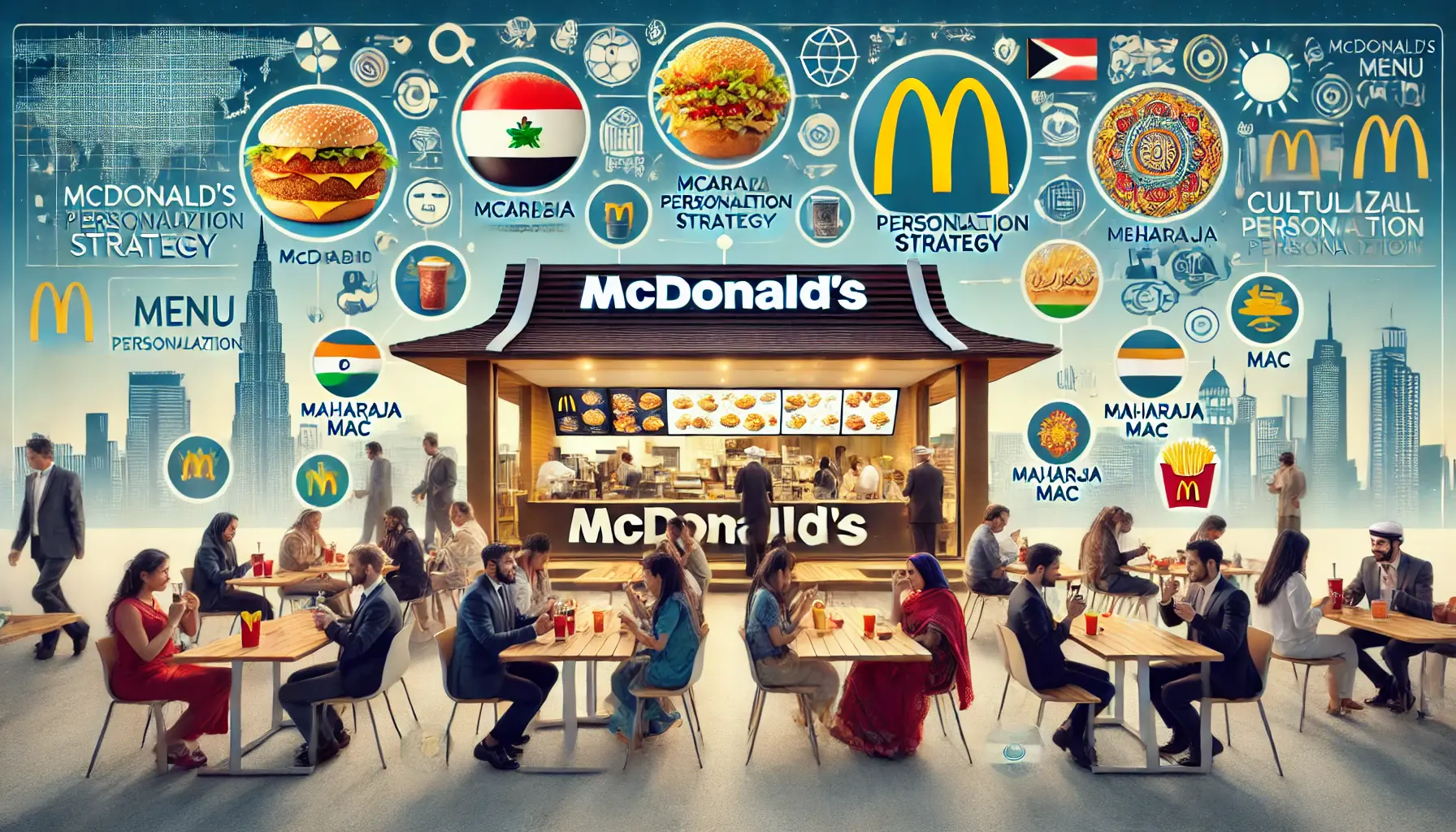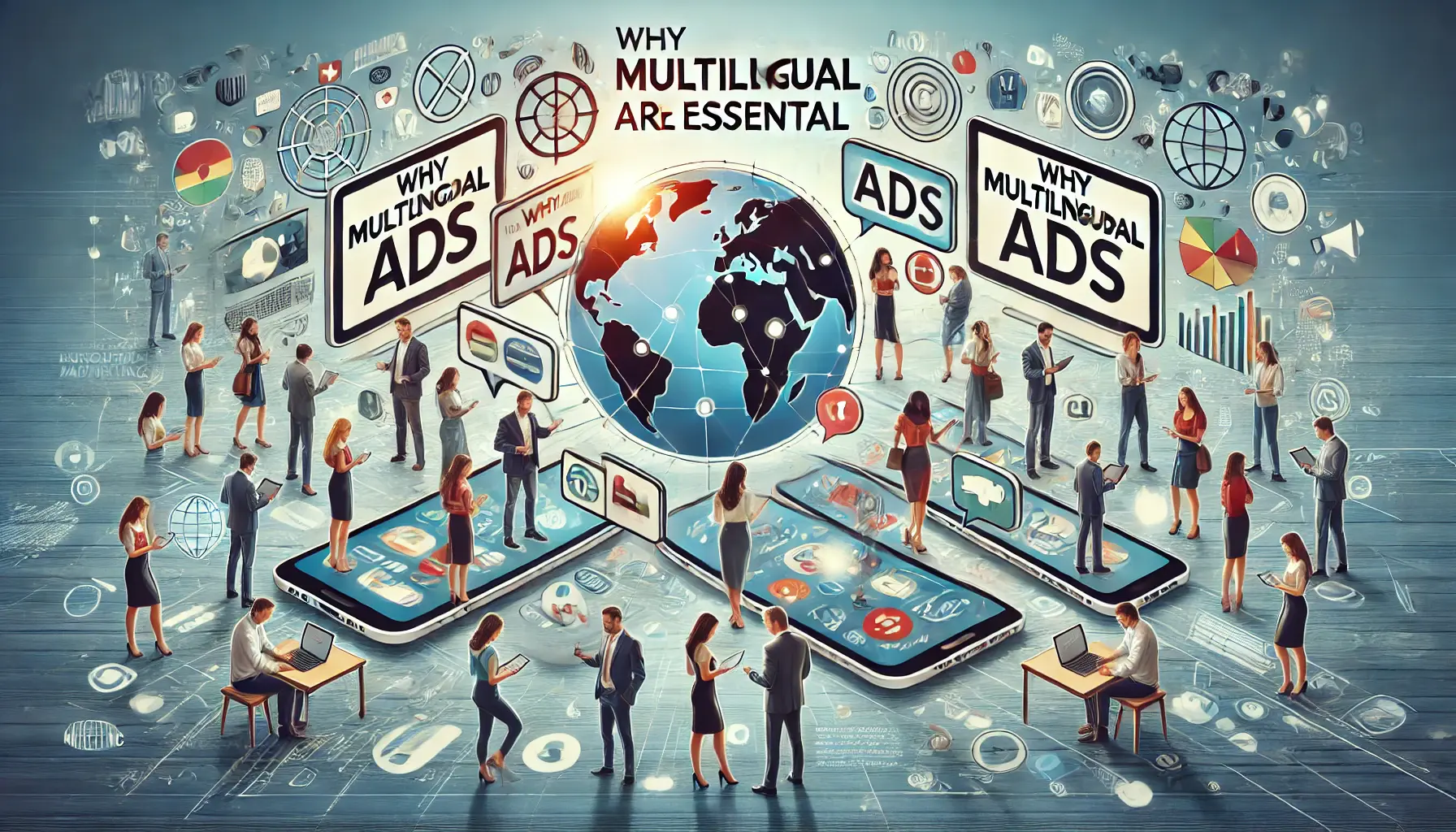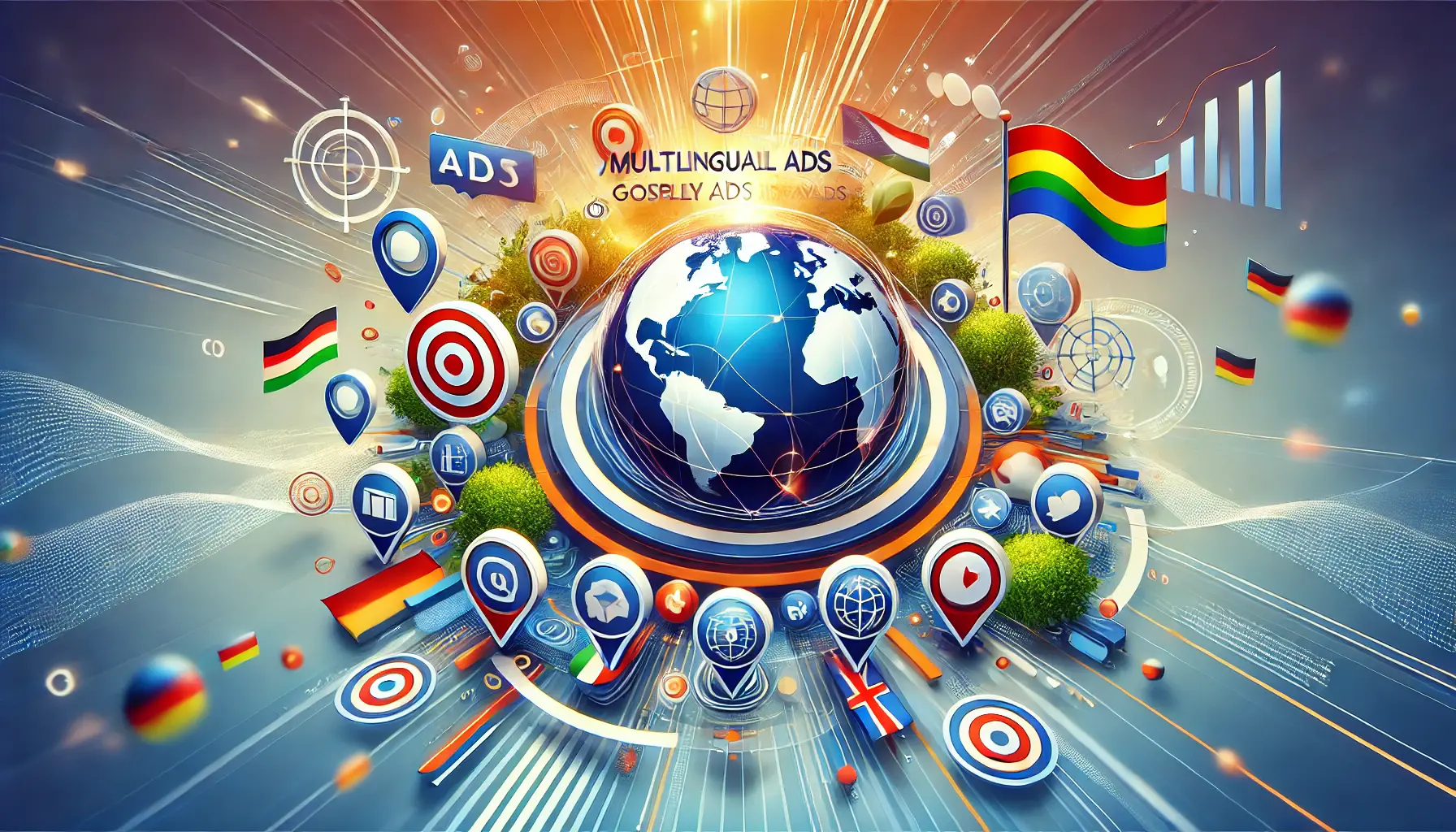In the digital world, no enterprise can dream of becoming truly global without thinking beyond borders.
One of the most effective ways to do so is through multilingualInvolving or using multiple languages. ads.
By crafting messages that resonate in native languages, a company can break barriers and foster meaningful connections with audiences.
Multilingual ads on Google Display Ads offer an opportunity to dive into diverse markets and make your brand seen and understood all over the world.
If you still haven’t harnessed the power of multilingual ads, then you’re surely losing out on one big competitive advantage.
In this article, we take a look at the importance of multilingual advertising, how to create effective multilingual Google Display Ads, and some actionable ways to optimize their performance.
Let’s begin with why multilingual ads are crucial for global campaigns.
- Why Multilingual Ads Are Crucial for Global Campaigns
- How to Create Effective Multilingual Google Display Ads
- Top Tools and Techniques for Managing Multilingual Ads
- Optimizing Performance of Multilingual Display Ads
- Case Studies: Successful Multilingual Google Display Campaigns
- The Power of Multilingual Advertisements for International Success
- FAQs About Multilingual Ads
Why Multilingual Ads Are Crucial for Global Campaigns
Multilingual ads are not just an option but a necessity for businesses looking to expand internationally.
By using multilingual advertising, you ensure your message is accessible to diverse audiences, which is vital in today’s interconnected world.
Let’s delve into the reasons why multilingual ads play a pivotal role in global campaigns.

Highlighting the importance of multilingual ads in connecting diverse audiences through inclusive and culturally relevant communication.
Understanding the Importance of Multilingual Ads
Language is more than just a tool for communication; it is a gateway to culture.
When your ads speak the language of your target audience, it establishes trust and relatability.
This cultural alignment makes customers more likely to engage with your brand, leading to increased conversions.

Showcasing the power of multilingual campaigns to connect with diverse audiences worldwide through inclusive and targeted messaging.
Reaching Diverse Audiences with Multilingual Campaigns
The world is home to over 7,000 languages, and a significant portion of internet users prefer content in their native tongue.
By tailoring your ads to multiple languages, you open the door to millions of potential customers who might otherwise feel alienated by monolingual content.
- Enhance brand accessibility across different demographics.
- Show your commitment to inclusivity and understanding.
- Expand your reach in both emerging and established markets.

Highlighting the role of language localization in boosting ad performance through tailored and culturally relevant messaging.
How Language Localization Enhances Ad Performance
Localization goes beyond translation; it involves adapting your message to fit the cultural nuancesSubtle differences or details that are important for understanding context. and preferences of your target audience.
Properly localized multilingual ads often perform better because they align with the expectations and values of local consumers.
- Improves click-through rates (CTR) and engagement.
- Boosts brand credibility and authority in local markets.
- Minimizes miscommunication and potential cultural missteps.

Visualizing the global market trends that drive the need for multilingual advertising strategies.
Global Market Trends Requiring Multilingual Strategies
With increasing internet penetration in non-English speaking regions, multilingual strategies are no longer optional.
As global giants like Google and Amazon invest heavily in multilingual content, this becomes the standard for all businesses around the world.
- The rise of mobile-first users in developing countries demands language inclusivity.
- Shifting consumer behaviors favor brands that offer localized experiences.
- Multilingual ads drive better ROI in competitive markets.
Understanding these trends and benefits shows the undeniable value of multilingual ads.
In the next section, we’ll explore practical steps to create highly effective multilingual Google Display Ads.
Multilingual ads are vital for expanding your business globally by connecting with diverse audiences through culturally relevant messaging.

Illustrating the process of creating impactful multilingual Google Display Ads through effective tools and localization strategies.
How to Create Effective Multilingual Google Display Ads
Creating effective multilingual Google Display Ads requires more than just translating your existing content into another language.
It means understanding your target audience, their culture, and their unique preferences.
A well-executed strategy ensures that your ads resonate with diverse audiences and drive meaningful engagement.

Illustrating the best practices in translating and localizing ad copy for global audiences, focusing on accuracy and cultural relevance.
Best Practices for Ad Copy Translation and Localization
Translation is the first step, but localizationThe process of adapting content to fit the cultural and linguistic context of a specific region. takes your ads to the next level.
Localization involves adapting the ad copy, visuals, and even colors to suit the cultural norms and preferences of your audience.
Here’s how to do it effectively:
- Hire professional translators who understand the nuances of the target language.
- Incorporate culturally relevant phrases or idioms to connect with the audience.
- Ensure that visuals and symbols are appropriate and culturally sensitive.

Showcasing the powerful Google Ads tools used for managing and optimizing multilingual campaigns.
Using Google Ads Tools for Multilingual Campaigns
Google Ads offers several built-in tools to help you manage multilingual campaigns seamlessly.
These tools ensure that your ads are optimized for different languages and regions:
- Dynamic Search Ads: Automatically create ads based on your website content and translate them for different languages.
- Google’s Location Targeting: Focus on specific regions where your target language is predominantly spoken.
- Ad Preview and Diagnosis: Test how your ads appear in various languages and regions before they go live.

Emphasizing the importance of cultural relevance in ads by showcasing diverse perspectives and cultural sensitivity in digital marketing.
Tips for Ensuring Cultural Relevance in Ads
Cultural relevance is a cornerstone of effective multilingual advertising.
If your ads feel out of place or irrelevant, they won’t resonate with your audience.
Consider the following tips:
- Research the cultural preferences and sensitivities of your target audience.
- Avoid using slang or colloquial terms that may not translate well.
- Test ad variations with a focus group from the target culture.

Illustrating the common mistakes to avoid in multilingual advertising, such as incorrect translations and cultural missteps.
Common Mistakes to Avoid in Multilingual Advertising
Many businesses make avoidable mistakes when launching multilingual ads.
These errors can cost you valuable engagement and conversions.
Here are common pitfalls and how to avoid them:
- Direct Translation: Avoid word-for-word translations, as they can lead to awkward or incorrect messaging.
- Ignoring Regional Dialects: A single language can have multiple dialects; tailor your ads accordingly.
- Skipping Quality Assurance: Always review your ads for grammatical errors and cultural accuracy before publishing.
By following these steps, you can create impactful multilingual Google Display Ads that resonate with diverse audiences and help achieve your global marketing goals.
In the next section, we’ll explore tools and techniques to streamline the management of your multilingual campaigns.
Creating multilingual ads involves high-quality localization and a deep understanding of cultural nuances to maximize engagement and conversions.

Showcasing the top tools and techniques for managing multilingual ads, focusing on translation software, optimization, and global targeting.
Top Tools and Techniques for Managing Multilingual Ads
Managing multilingual ads can be a challenging task, but with the right tools and techniques, it becomes more efficient and streamlined.
Whether you are working with a small team or managing campaigns for a global enterprise, leveraging these resources ensures that your ads are consistent, culturally appropriate, and optimized for success.

Showcasing Google’s built-in multilingual ad features for managing global campaigns through advanced targeting and dynamic ad tools.
Google’s Built-in Multilingual Ad Features
Google Ads provides several built-in features to support multilingual campaigns.
These features make the creation, translation, and optimization processes easier:
- Dynamic Search Ads: Automatically generate ads based on your website content, making scaling campaigns across multiple languages easier.
- Language Targeting: Customize your campaigns to target specific languages, ensuring your ads appear to the right audience.
- Google Translator Toolkit: Assists in translating ad copy while maintaining accuracy and relevance.

Illustrating the use of third-party tools to efficiently manage ad localization for global campaigns.
Third-Party Tools to Streamline Ad Localization
Beyond Google Ads, there are a number of third-party tools that can help manage and localize multilingual ads.
These tools offer advanced features for translation and cultural adaptation:
- Smartling: Provides real-time translation and localization services to ensure your ads are tailored for specific regions.
- Transifex: A robust platform for managing multilingual content and coordinating with translators.
- Phrase: Focuses on simplifying the translation process with features like translation memory and collaborative workflows.

Showcasing the role of AI and machine translation in enhancing and automating multilingual campaigns.
AI and Machine Translation for Multilingual Campaigns
Artificial intelligence (AIArtificial Intelligence, a technology that enables machines to perform tasks that typically require human intelligence.) and machine translation tools are revolutionizing multilingual advertising.
These technologies enhance efficiency and reduce costs:
- DeepL: Provides highly accurate translations with a nuanced understanding of language context.
- Google Translate API: An economical way to integrate automated translations into your workflow.
- Microsoft Translator: Supports more than 70 languages and integrates seamlessly with other marketing tools.

Emphasizing the importance of professional translators in the translation and localization process, highlighting teamwork and cultural expertise.
Working with Professional Translators
While tools are important, human professionals add a level of cultural sensitivity and contextual accuracy.
Professional translators and native speakers can localize your ads with a personal touch:
- Native speakers who understand the cultural nuances of your target audience.
- Translation agencies specializing in marketing content for higher accuracy.
- Combining machine translation with human editing for optimal results.
By utilizing the tools and techniques mentioned above, you can effectively manage and optimize your multilingual ad campaigns.
In the next section, we’ll discuss strategies for maximizing the performance of your multilingual display ads.
Utilizing tools like Google Ads features, third-party platforms, and AI ensures efficient management and localization of multilingual campaigns.

Illustrating the optimization of multilingual display ads through performance tracking and regional customization.
Optimizing Performance of Multilingual Display Ads
Creating multilingual ads is just the beginning; the real magic begins with optimizing their performance to get the best return on your investment.
By analyzing data, testing strategies, and fine-tuning, you can achieve significantly different—and sometimes surprising—results from market to market.
This section explores proven methods to maximize the effectiveness of your multilingual display ads.

Illustrating the analysis of key metrics in multilingual campaigns to optimize performance and measure success.
Analyzing Key Metrics for Multilingual Campaigns
Understanding and analyzing performance metrics is essential to gauge the success of your campaigns.
Focus on these key metrics:
- Click-Through Rate (CTR): Measure how engaging your ads are across different languages and regions.
- Conversion Rate: Track the percentage of users who take action after clicking your ad.
- Cost Per Acquisition (CPA): Evaluate the cost-effectiveness of your multilingual campaigns.
- Engagement Metrics: Assess how long users interact with your content after clicking.

Illustrating A/B testing strategies for optimizing multilingual ads by testing different versions targeting various languages and regions.
A/B Testing Strategies for Multilingual Ads
A/B testing is a powerful way to identify what resonates best with your audience.
Test variations of your ads in different languages to refine your approach:
- Experiment with headlines and taglines in localized versions.
- Test different visuals and layouts tailored to specific cultural preferences.
- Compare the performance of region-specific call-to-actions (CTAs).
Use the results to continuously optimize your ad copy and design for each language group.

Illustrating the adjustment of targeting strategies for different language groups, emphasizing location, language preferences, and demographic insights.
Adjusting Targeting for Different Language Groups
Effective targeting ensures your ads reach the right audience.
Adjust targeting parameters based on language and cultural relevance:
- Location-Based Targeting: Focus on regions where the language is predominantly spoken.
- Demographic Insights: Tailor your ads to age groups, income levels, or interests specific to the culture.
- Device Preferences: Optimize for devices popular in specific regions, such as mobile-first markets.

Illustrating the use of customer feedback, such as reviews and surveys, to refine and improve ad content in multilingual campaigns.
Using Customer Feedback to Refine Ad Content
Customer feedback is invaluable for improving multilingual ads.
Observe direct feedback and social media interactions to identify areas for improvement:
- Analyze reviews and comments for insights into cultural relevance.
- Incorporate suggestions to make ads more relatable and engaging.
- Conduct surveys to gather specific feedback from your audience.
Acting on this feedback demonstrates that your brand values diversity in its customer base, fostering loyalty and trust.
By following these tips, you can ensure your multilingual display ads reach targeted audiences and perform exceptionally well.
In the next section, we’ll examine case studies of brands that have successfully implemented multilingual advertising to inspire your campaigns.
Regularly analyze key metrics like CTRClick-Through Rate, a metric that measures the ratio of users who click on an ad to the total number of users who view it. and CPACost Per Acquisition, a metric that measures the cost of acquiring a new customer or lead., perform A/B testing, and adjust targeting to enhance the performance of multilingual ads.

Illustrating successful multilingual Google Display campaigns through case studies, with a focus on performance analysis and positive results.
Case Studies: Successful Multilingual Google Display Campaigns
Seeing real-world examples of successful multilingual advertising can be both inspiring and educational.
These case studies showcase how brands have leveraged multilingual Google Display Ads to reach global audiences, overcome cultural barriers, and achieve impressive results.
Let’s dive into some notable campaigns.

Illustrating Coca-Cola’s ‘Share a Coke’ campaign, emphasizing personalization and inclusivity through shared experiences.
How Coca-Cola Connected Through ‘Share a Coke’
Coca-Cola’s ‘Share a Coke’ campaign is a textbook example of effective localization.
By putting popular names in many languages on its bottles, Coca-Cola made the brand personalized on a personal level.
The campaign included:
- Customized ad creatives for each target region.
- Localized social media content to enhance engagement.
- Increased brand awareness and loyalty through cultural alignment.
Result: Coca-Cola saw a significant boost in sales and brand engagement across multiple regions.

Illustrating Airbnb’s global expansion and growth through multilingual ads, highlighting the brand’s global reach and cultural adaptation.
Airbnb’s Global Growth Through Multilingual Ads
Airbnb leveraged multilingual ads to establish itself as a global leader in the hospitality industry.
The campaign focused on:
- Localized messaging that resonated with different cultural values.
- Dynamic ad creatives showcasing listings in the target audience’s region.
- Language-specific landing pages to improve user experience and conversions.
Result: Airbnb experienced increased bookings and expanded its footprint in emerging markets.

Illustrating McDonald’s menu personalization strategy, emphasizing the adaptation of offerings to regional tastes and cultural preferences.
McDonald’s Menu Personalization Strategy
McDonald’s has a long history of adapting its marketing campaigns to local cultures.
Their multilingual Google Display Ads featured:
- Localized menu items, such as the McArabia and Maharaja Mac.
- Culturally relevant ad copy and visuals to build trust with local audiences.
- Promotions tied to regional festivals and holidays.
Result: McDonald’s strengthened its brand presence and deepened customer loyalty in diverse markets.

Illustrating Duolingo’s multilingual expansion strategy, with users from different backgrounds learning languages on various devices.
Duolingo’s Multilingual Expansion Strategy
As a language learning app, Duolingo naturally uses multilingual advertising to connect with its audience.
Key tactics included:
- Designing ad copy in more than 20 languages to match the preference of the target audience.
- Communicating language-specific courses and unique app features.
- Using user testimonials in various languages to establish credibility.
Result: Duolingo became one of the most downloaded education apps in the world, with a higher user retention rate.
These case studies show the possibilities of multilingual Google Display Ads when done correctly.
Building on that success, you can create campaigns that truly resonate with diverse audiences and drive meaningful results.
Learning from brands like Coca-Cola and Airbnb demonstrates how tailored multilingual strategies lead to global success.

Illustrating the power of multilingual advertisements in driving international success through global reach and targeted messaging.
The Power of Multilingual Advertisements for International Success
Perusing this article has underlined the immense potential for multilingual advertisements in today’s globalized world.
From understanding their importance to exploring case studies of successful campaigns, it is clear that leveraging multilingual Google Display Ads can significantly expand your brand’s reach and impact.

Emphasizing the importance of multilingual ads in reaching diverse global audiences and fostering connections across cultures.
Why Multilingual Ads Are Essential
Multilingual advertising is more than a trend; it’s a necessity for businesses aiming to connect with diverse audiences.
By speaking the language of your target market, you create trust, improve engagement, and establish a deeper cultural connection.
This is a vital step in standing out in an increasingly competitive global market.

Emphasizing the importance of teamwork, strategic planning, and data-driven decision-making in achieving success.
Key Strategies for Success
Throughout this article, we’ve outlined actionable strategies to make your multilingual ads effective:
- Focus on high-quality translation and localization to ensure cultural relevance and precision.
- Leverage Google Ads tools and third-party platforms to manage campaigns efficiently.
- Use AI and machine translation combined with human expertise to maintain accuracy.
- Regularly analyze metrics like CTR, CPA, and engagement to refine campaigns.
- Incorporate customer feedback to continuously improve ad performance.

Illustrating the importance of learning from real-world success stories to inform future campaign strategies.
Learning from Success Stories
Case studies from brands like Coca-Cola, Airbnb, McDonald’s, and Duolingo demonstrate how multilingual Google Display Ads can achieve remarkable results.
These companies showed that understanding local cultures, adapting strategies, and staying relevant can create campaigns that not only perform well but also resonate deeply with audiences.

Reflecting on key insights and strategic thinking as a group of marketers discuss the final thoughts on their campaign analysis.
Final Thoughts
The world of advertising is constantly evolving, and embracing multilingual ads is a crucial step toward staying ahead.
By implementing the insights shared in this article, your business can tap into new markets, build meaningful connections, and drive growth.
The key to success lies in being flexible, continuously improving your strategies, and never forgetting the power of cultural relevance in advertising.
Whether you’re a global player or a small business looking to expand its reach, multilingual Google Display Ads offer unprecedented possibilities to reach audiences across the globe.
Begin building your strategy now and give your brand a new dimension of growth.
Embracing multilingual ads is essential for businesses aiming to build cultural connections and achieve international growth.

Illustrating a collaborative discussion on frequently asked questions about multilingual ads, focusing on key insights and market understanding.
Your campaigns can be managed by an agency specialized in Google Ads, check out our service page.
FAQs About Multilingual Ads
Below are some of the most frequently asked questions regarding multilingual ads and how they should be used in Google Display Ads.
These responses will help illustrate key concepts and provide actionable insights for your campaign work.
Multilingual ads are a kind of ad creative authored in several languages to target different audience segments.
They help businesses reach global customers by delivering localized and culturally relevant messaging in native languages.
They allow your business to expand its reach and connect with diverse audiences.
The use of native languages fosters trust, improves engagement, and enhances conversions across a variety of regions and cultural groups.
Focus on high-quality translations, cultural relevance, and proper localization.
Use Google Ads tools, work with professional translators, and test your ads to ensure they resonate with your target audience in each language.
Google Ads features like Dynamic Search Ads and location targeting are great options.
Third-party tools like SmartlingA cloud-based translation and localization software for global content management., TransifexA platform for managing and translating multilingual content., and Phrase also simplify translation and localization for multilingual campaigns.
Common mistakes include direct translations without localization, ignoring regional dialects, and failing to test ad performance.
These errors can lead to cultural missteps and reduce the effectiveness of your campaigns.
Track key metrics like click-through rates (CTR), conversion rates, and cost per acquisition (CPA).
Analyze engagement metrics to determine how well your ads resonate with audiences across different languages.
Cultural relevance ensures your ads align with the values and norms of your audience.
This fosters trust, improves engagement, and enhances the overall effectiveness of your campaigns in different regions.
Yes, AI tools like DeepLAn advanced AI-powered translation tool known for its high accuracy. and Google Translate API can help with translations.
However, combining AI with human editing ensures accuracy and maintains cultural nuances in your multilingual ads.
Industries like e-commerce, travel, education, and technology benefit significantly.
Businesses in these sectors can connect with global audiences and enhance user experience through localized and multilingual advertising strategies.











